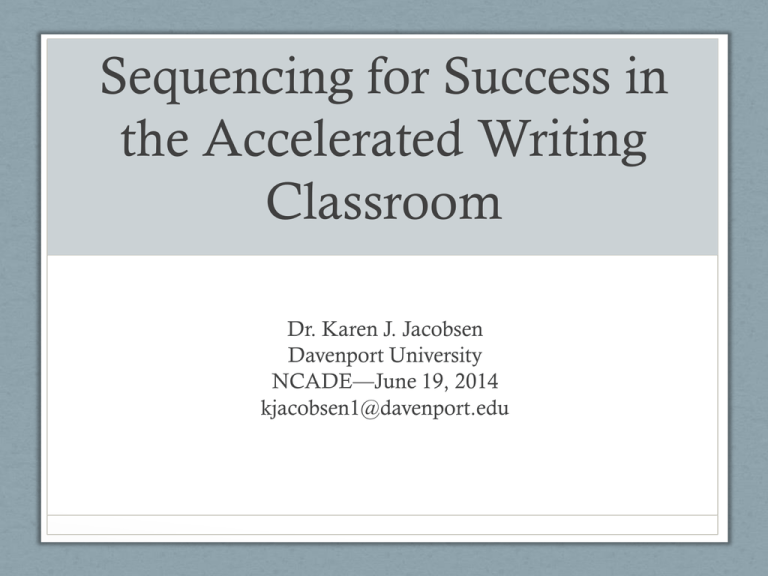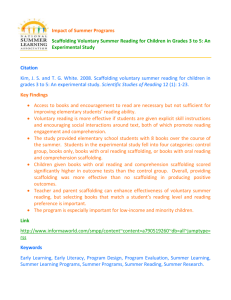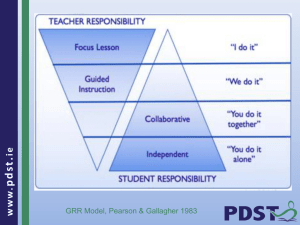PPTX
advertisement

Sequencing for Success in the Accelerated Writing Classroom Dr. Karen J. Jacobsen Davenport University NCADE—June 19, 2014 kjacobsen1@davenport.edu Overview of Scaffolding Theory • L. S. Vygotsky (1896-1934): Proximal Zone of Development (PZD) The distance between the actual development as determined by independent problem solving and the level of potential development as determined through problem solving under adult guidance or in collaboration with more capable peers. (1978, p. 86) Six Principles of Scaffolding -(Leo Van Lier, 1996, p. 196) • Contextual support—a safe environment; students are challenged, but errors are okay and a crucial part of the learning process • Continuity—repetition of skills over time; balance between routine and variation • Intersubjectivity—mutual engagement & support; collaborative learning Six Principles of Scaffolding • Flow—communication between participants not forced but flows in natural way • Contingency—level of scaffolding depends on learners’ reactions; activities can be added, changed, and deleted • Handover—learner is ready to perform activities successfully without assistance Applying PZD Theory to the ALP Classroom Example: Ad Analysis Assignment (Handout) • Skills: close reading, description, application of readings’ ideas to analysis, summarizing/paraphrasing, quoting, documentation • Careful sequencing of assignments between the composition classroom (ENGL 109) & the lab class (ENGL 021L) Scaffolding Assignments (ENGL 021L) • Extra help with readings: annotating, discussion questions, and vocabulary • Testing authors’ theories as a class: finding alcohol ads via Internet and testing Kilbourne’s ideas (instructor-led activity) Emphasizing Contextual support, Continuity, Intersubjectivity, & Flow Scaffolding Assignments (ENGL 021L) • Students find and/or create magazine ads and present analysis to class • Peer review workshops on drafts, including APA documentation; individual conferences with instructor Emphasizing Contingency & Handover (taking down parts of scaffolding to promote autonomy) What Happens in the ENGL 109 Class? • All students do ad analysis activity; lab students gain additional knowledge from “more capable peers,” but often the lab students become the leaders • More formalized peer review workshop; lab students receive feedback from more experienced writers, but lab students more confident in giving constructive feedback Sequencing Between Assignments Next Essay Assignment: Summary/Response (Handout) • Build on previous skills: summarizing ideas, analyzing message/claims of a text; documenting information • New skills (new PZD): formulating a logical, well-reasoned response to a text; finding and evaluating sources from the library’s databases Scaffolding Assignments (ENGL 021L) • Extra time/support researching databases and evaluating sources • Practice summary and response assignment using a sample article (Instructor led) • Contingency & Handover (Taking down scaffolding=autonomy): Peer Review workshops on multiple drafts for Essay Three; individual conferences with instructor Lessons Learned • Important to continually assess Contingency principle (for class as a whole and individual students) • Embrace the Handover process • All students can benefit from scaffolding approach; division blurred between ENGL 109 and ENGL 021L student References Barnard, R., & Campbell, L. (2005). Sociocultural theory and the teaching of process writing: The scaffolding of learning in a university context. The TESOLANZ Journal, 13, 76-88. Van Lier, L. (1996). Interaction in the curriculum: Awareness, autonomy & authenticity. London: Addison Wesley Longman. Vygotsky, L. S. (1978). Mind in society: The development of higher psychological processes. Cambridge, MA: Harvard University Press. Wood, D., Bruner, J.S., & Ross, G. (1976). The role of tutoring in problem solving. Journal of Child Psychology and Psychiatry, 17, 89-100.





